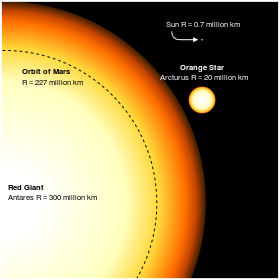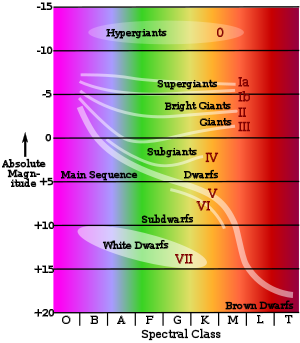
Red giant
Did you know...
SOS Children, which runs nearly 200 sos schools in the developing world, organised this selection. Before you decide about sponsoring a child, why not learn about different sponsorship charities first?
A red giant is a luminous giant star of low or intermediate mass that is in a certain late phase of its evolution. Unlike a main sequence star such as our Sun, a red giant shines primarily with energy from helium fusion, not hydrogen. Helium fusion begins suddenly, and the star leaves the main sequence, after a period of contraction caused by decreased hydrogen reactions. If hydrogen fusion continues at a different depth within the star, it will shine brighter as an asymptotic giant branch star. Increased power output heats the star's outer hydrogen, causing it to expand to a much greater radius and lower density. Although the decreased hydrogen density may result in decreased hydrogen power output, the independent helium power source pushes expansion beyond the characteristics of main sequence stars. At the edge of this expanded atmosphere, the temperature is below 5000 K, resulting in a redder colour. Astronomers infer red giant status from the K and M stellar classes, but a small fraction of far developed red giants belong to the carbon stars, mostly of class C-N and late C-R.
Prominent bright red giants in the night sky include Aldebaran (Alpha Tauri), and Gamma Crucis (Gacrux), while the even larger Antares (Alpha Scorpii) and Betelgeuse (Alpha Orionis) are Red supergiants.
Characteristics and lifespan
Red giants are evolved from main sequence stars with masses in the range from about 0.5 solar masses to somewhere between 4 and 6 solar masses .
Red giants are stars with radii tens to hundreds of times larger than that of the Sun which have exhausted the supply of hydrogen in their cores and switched to fusing hydrogen in a shell outside the core. Since the inert helium core has no source of energy of its own, it contracts and heats up, and its gravity compresses the hydrogen in the layer immediately above it, thus causing it to fuse faster. This in turn causes the star to become more luminous (from 1,000 to 10,000 times brighter) and expand; the degree of expansion outstrips the increase in luminosity, thus causing the effective temperature to decrease. In stars massive enough to ignite helium fusion, an analogous process occurs when central helium is exhausted and the star switches to fusing helium in a shell, although with the additional complication that in many cases hydrogen fusion will continue in a shell at lesser depth — this puts stars onto the asymptotic giant branch. The decrease in surface temperature shifts the star's visible light output towards the red — hence red giant, even though the colour usually is orange. Main sequence stars of spectral types A through K are believed to become red giants.
Very low mass stars are thought to be fully convective and thus may not accumulate an inert core of helium, and thus may exhaust all of their fuel without ever becoming red giants. Such stars are commonly referred to as red dwarfs. The predicted lifespan of these stars is much larger than the current age of the universe, and hence there are no actual observations of these stars aging.
Very high mass stars instead develop to supergiant stars that wander back and forth horizontally over the HR diagram, at the right end constituting red supergiants. These usually end their life as type II supernovae.
If the star is heavier than 0.4 but less than 2.57 solar masses, the addition of helium to the core by shell hydrogen fusing will cause a helium flash — a rapid burst of helium fusing in the core, after which the star will commence a brief period of helium fusing before beginning another ascent of the red giant branch. Stars more massive than 2.5 solar masses, but less than about 4 to 6, enter the helium fusing phase of their lives much more smoothly. The core helium fusing phase of a star's life is called the horizontal branch in metal-poor stars, so named because these stars lie on a nearly horizontal line in the Hertzsprung-Russell diagram of many star clusters. Metal-rich helium-fusing stars do not lie on a horizontal branch, but instead lie in a clump (the red clump) in the Hertzsprung-Russell diagram.
Actually, such stars are not big red spheres with sharp limbs (when one is close to it) as displayed on many images. Due to the very low density such stars may not have a sharp photosphere but a star body which gradually transfers into a ' corona'.
The Sun as a red giant
The Sun is expected to become a red giant approximately 5 billion years from now. It is calculated that the Sun will become sufficiently large to engulf the current orbits of the solar system's inner planets, including Earth and potentially Mars and its radius will expand a minimum of 200 times, The Sun will lose a significant fraction of its mass in the process of becoming a red giant, there is a chance that Mars and all the outer planets will escape as their resulting orbits will widen. Mercury and most likely Venus will have been swallowed by sun's outer layer at this time. Earth's fate is less clear. Venus and Earth could technically achieve a widening of its orbit and could potentially maintain a sufficiently high angular velocity to keep it from becoming engulfed. In order to do so, its orbit would increase to 1.3 AU (190,000,000 km) and 1.7 AU (250,000,000 km). However the results of studies announced in 2008 show that due to tidal interaction between sun and Earth, Earth would actually fall back into a lower orbit, and get engulfed and incorporated inside the sun before sun reaches its largest size, despite the sun losing about 38% of its mass. Before this happens, Earth's biosphere will have long been destroyed by the Sun's steady increase in brightness as its hydrogen supply dwindles and its core contracts, even before the transition to a Red Giant. After just over 1 billion years, the extra solar energy input will cause Earth's oceans to evaporate and the hydrogen from the water to be lost permanently to space, with total loss of water by 3 billion years. Earth's atmosphere and lithosphere will become like that of Venus. Over another billion years, most of the atmosphere will get lost in space as well;, ultimately leaving Earth as a desiccated, dead planet with a surface of molten rock.



